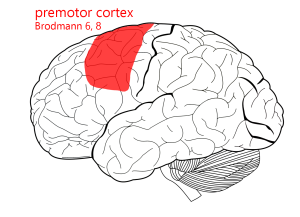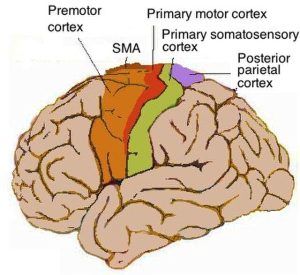Premotor and Supplementary Motor Cortex
Caleb Bevan
Premotor Cortex

Introduction
The earliest research about the premotor cortex was done in 1905 by Dr. Campbell. He was the first one to suggest that the motor cortex might be separated into at least two different regions because of the analysis of the neural tissue itself (the premotor cortex is one of the many subdivisions of the motor cortex). After some time there was many disagreements and the loss of the term premotor cortex till the 1980s with many researchers providing more data in support of the idea of the premotor cortex. Overtime the other areas of the motor cortex were also found and studied to what we have now which is a plethora of areas in the motor cortex in charge of different functions/movements.
The premotor cortex is located posterior to the frontal lobe. The premotor cortex might also be referred too as Broadman’s area 6 or 8 (see image above). Is is one of the main subdivisions of the motor cortex which is the main hub for motor signals from your brain.
Subdivisions of the Premotor Cortex
There are two subdivisions of the premotor cortex; the Dorsal premotor cortex and the Ventral premotor cortex. Both are named by the sub location in the premotor cortex.
The dorsal premotor cortex (PMd) in primarily in charge of guiding reaching, complex movements of arm, use of sensory stimuli in movements, and relating to eye movement.
the ventral premotor cortex (PMv) is also in charge of sensory guidance of movement along with shaping hand/grasping of hand.
Both parts of the premotor cortex are constantly working together in almost all movement in the body most importantly the arm and hand.
Connectivity
-
- Cortical inputs: Prefrontal cortex, parietal lobe
-
Outputs: M1, brainstem, spinal cord
-
Outgoing connections: motor cortex, spinal cord, basal ganglia, cerebellum
Functional Roles
Many functions of the premotor cortex are still not fully understood to this date. There is research to support that the premotor cortex is used for things including spatial guidance in movement, planning out movement, and observing the actions of others. They use all of these things to make a movement that is appropriate for the situation.
Motor Planning and Preparation
-
- Role in preparing movements before execution
-
Sequencing of motor acts
Sensorimotor Integration
-
-
Processing of visual and sensory inputs to guide movement
-
Goal-Directed Movements
-
-
Reaching, grasping, and tool use
-
Movement selection based on cues
-
Motor Learning and Skill Acquisition
-
-
Role in associative and observational learning
- Watching others and putting into practice the movement
-
Complex movements such as reaching or climbing demand greater coordination, the integration of more control variables, the tracking of objects in the nearby environment, and the ability to plan actions seconds ahead. In contrast, simpler components of the motor system—like moving an object with your fingers after it has been grasped, or using your mouth to manipulate objects—require less foresight, reduced spatial computation, and rely more on fine control of joint movements and muscle fibers.
According to this, more complex, especially multi-joint, movements are represented more prominently in the anterior regions of the motor cortex. This area of the cortex tends to prioritize control over the back and neck, which functions as a key figure in bodily coordination. Simpler motor acts that primarily involve further muscles are emphasized further posteriorly within the motor cortex.
Interpretation suggests that while primary motor cortex is more involved in relatively simple movements and the premotor cortex in more complex ones, this spatial distinction does not indicate a control hierarchy. Rather, these regions are functionally distinct and internally diverse, reflecting the natural movement range of our bodies.
Supplementary Motor Area
Introduction
Supplementary Motor Area or SMA is the dorsal medial part of the frontal lobe (also shown in the image below). Neurons in the SMA apply directly to the neurons in your cortical spinal tract. There has been research to show they have a role in voluntary movement, stabilization of the body, and bimanual coordination. There is no affect from stimulation in the SMA and all movement is internally generated. Graziano and colleagues have looked at SMA and emphasis in locomotion (the ability for an organism to move from one place to another). They looked at the use in things like climbing or jumping and created a hypothesis that the SMA is related to locomotion.

Functional Roles
Pre-SMA
- Most anterior portion. It has no connections to spinal cord or motor cortex. Has connection in prefrontal areas.
-
-
Inputs: Basal ganglia, thalamus, prefrontal cortex
-
Outputs: M1, spinal cord (via corticospinal tract)
-
SMA proper
- The SMA proper is located at the top of the hemisphere partly on the medial well. Has been thoroughly researched in monkeys. One of the primary outputs of the cortical motor system through the spine.
-
- Inputs: Same as Pre-SMA
-
Outputs: Same as Pre-SMA
Supplementary Eye Field
- When stimulated causes head and eye movements.
Dum and Strick
- Connections to spinal cord and cingulate sulcus. Has not been thoroughly studied and is theorized to deal with emotions
References
Campbell, A. W. (1905). Histological studies on the localisation of cerebral function. University Press.
Graziano, M. S. (2023). Fundamental principles of cortical organization reflected in a new study. Neuron, 111(10), 1524-1525.

